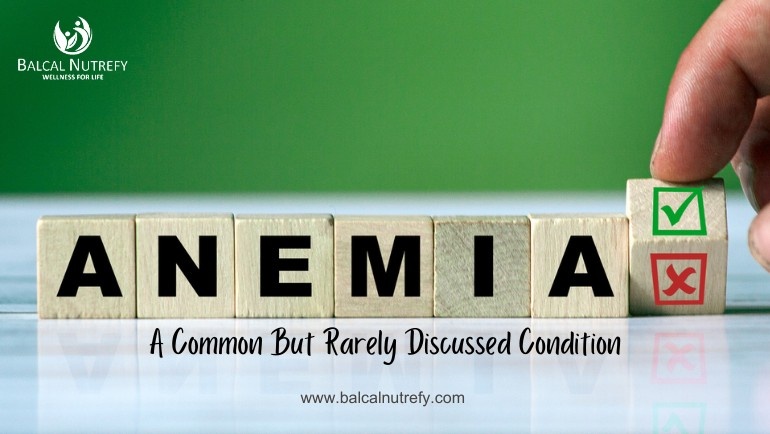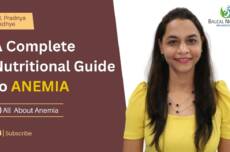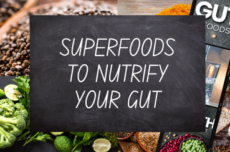
Anemia is a health concern impacting majorly women, adolescent girls, and young children, yet it largely remains unnoticed and unaddressed. As per the World Health Organization, Anemia is a medical condition characterized by a decreased number of red blood cells or a lower-than-normal concentration of haemoglobin in the blood. Red blood cells are an essential component of blood and are responsible for carrying oxygen to various parts of the body. Based on the latest National Family Health Survey, during the last half-decade, anemia, mostly occurring among women and children, has become worse in most states/union territories. In 2019, anemia was detected in 68.4% of youngsters and 66.4% of all women, compared to 35.7% of kids and 46.1% of women in 2016. In this blog, we will explore the causes, symptoms, and treatment of Anemia.
Let us, first understand what causes Anemia?
- Deficiency of Iron: Intake of food deficient in iron or poor food intake can contribute to anemia. Poor absorption of iron from the diet also leads to anemia. Iron is either derived, from plant-based foods in the form of non-heme iron or animals in the form of heme iron. Heme iron has a high absorption of up to 35%. However, non-heme iron is poorly absorbed (up to 8.7%) due to certain inhibitors present in the diet.
- Menstrual Flow: Heavy menstrual flow during menses is the most common cause of anemia in women. Apart, from that, lack of awareness and poor dietary intake of iron-rich foods also lead to anemia.
- Deficiency of Vitamin B12, Folic Acid, and Vitamin C: Vitamin B12 is crucial in making red blood cells and proteins. Folate works with iron in the production of red cells. Vitamin C is important for the absorption of iron. A diet lacking in any of these micronutrients can lead to anemia.
- Auto-immune Reaction or Genetics: These conditions involve the premature destruction of red blood cells, leading to a shorter lifespan of these cells. Having a family history can increase the risk of inherited anemia like sickle cell anemia.
What are the symptoms of anemia?
- Fatigue & Weakness: Due to a low red blood cell count, the body’s organs and tissues do not receive enough oxygen, and hence, there is a sense of general weakness and fatigue.
- Pale Skin and Nail Beds: A noticeable paleness of the skin and nail beds can be indicative of anemia. Reduced haemoglobin levels result in decreased blood flow, leading to paler complexion.
- Shortness of Breath: Less oxygen supply to the body’s tissues can cause shortness of breath, especially during physical activities.
- Dizziness and Headache: Anemic individuals may experience dizziness and headaches, often accompanied by difficulty concentrating.
- Cold Hands and Feet: Poor blood circulation can result in cold hands, and feet, as the body struggles to maintain optimal body temperature.
If you are experiencing any of the above symptoms, it is time for you to do blood work and understand the blood test parameters.
Following are the blood tests that you can do –
- Complete Blood Count (CBC): A CBC is a standard blood test that provides information about the quantity and quality of blood cells.
- Serum Iron Studies: These tests assess the levels of iron in the blood and include –
- Serum Iron: The amount of iron in the blood.
- Total Iron-Binding Capacity (TIBC): The capacity of proteins in the blood to bind to iron.
- Ferritin: A protein that stores iron; low levels may indicate iron deficiency
- Vitamin B12 and Folic Acid: Blood tests help measure levels of vitamin B12 and folate to identify deficiencies that may cause anemia.
Here are a few ways of managing the anemia –
1. Incorporate iron-rich foods: Consuming iron-rich foods is essential. Good sources of iron include red meat, poultry, fish, lentils, beans, tofu, Dates, Dry fruits, and dark green leafy vegetables
2. Enhance Iron Absorption: Pairing iron-rich foods with vitamin C-rich foods helps in iron absorption.
For example, adding citrus fruits, lemons, tomatoes, or bell peppers to a meal can help improve iron absorption from plant-based sources.
3. Incorporate foods with vitamin B12: Vitamin B12 is primarily, found in animal products such as meat, fish, eggs, and dairy. For individuals following a vegetarian or vegan diet, fortified foods or B12 supplements may be necessary.
4. Incorporate foods with Folate: Foods rich in folate include dark green leafy vegetables (spinach, kale), legumes (lentils, chickpeas), fortified cereals, oranges, and avocados. A supplementation, of folic acid, is recommended in cases of severe deficiency or when dietary intake is insufficient.
5. Limiting foods that inhibit iron absorption: Intake of certain foods can inhibit the absorption of iron. For example, calcium can interfere with non-heme iron absorption, so avoid consuming calcium and iron-rich foods or supplements together.
6. Regular Meals: Eating regular, balanced meals can help maintain stable iron, b12 and folic acid levels.
7. Use iron cast vessels to cook food: Using cast-iron cookware can increase the iron content of foods, especially when cooking acidic dishes.
Anemia is a widespread health issue that can significantly impact an individual’s quality of life. Timely diagnosis and appropriate management are crucial to address anemia effectively. Whether it’s through dietary changes, supplementation, or medical interventions, addressing anemia is very important to lead a healthy life. If you suspect you may have anemia or are experiencing symptoms, consult with a healthcare professional for a thorough assessment and personalized treatment plan.
You can also try healthy recipes like Garden Cress Seeds Laddoo / Halim Ke Laddu, Grilled Chicken recipe, Spinach Soup, etc. If you like this blog do checkout out our latest video on Anemia where we have covered it’s symptoms, major causes & prevention tips along with the list of foods to have & avoid.
Find Us On – Instagram, Facebook, LinkedIn, Twitter, YouTube & Stay Tuned for more such insightful & informational blogs & videos.



